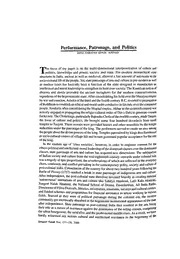
Performances, patronage, and politics PDF
Preview Performances, patronage, and politics
Performance, Patronage, and Politics SHEONARAYANSINGH 'ANIVED' The focus of my paperis on the multi-dimensional interpenetration ofculture and ...politics. knowledge and power, society and state. Pre-modem monarchical stale structuresinIndia,ancientaswellasmedieval,allowedafairamountofautonomytothe socio-culturallifeofthepeople.Yet,statepatronageofartsandcultureinpre-modemaswell as modem times has basically been a function of the state designed to manufacture an intellectualandmoralleadershiptostrengthenitshold oversociety.The Kautilyannotionof dharma and Janda provided the ancient metaphors for the modern consent/coercion ingredientsofthehegernonisiticstale.AfterconsolidatinghisholdovertheMauryanempire bywarandcoercion,Ashokaofthethird andthefourthcenturyB.C.resortedtopropagation ofBuddhismtoestablishanethicalandmoralorderconducivetohisruleovertheconquered people.Similarly,afterconsolidatingtheMughalempire,Akbarinthesixteenthcenturywas activelyengagedinpropagatingthereligio-culturalorderofDin-i-Ilahitogenerateconsent forhisrule.TheCholakings,particularlyRajendraCholaofthetwelfthcentury,madeTanjore the focus of culture and politics. He brought some four hundred devadasis from small templestoTanjore.These WOmenwere provided houses andotheramenitiesbythetemple authoritiesunderthepatronageoftheking.Theperformersservedtocreateanaweamong thepeopleaboutthedivinepowersoftheking.TemplespatronizedbykingsIhusfunclioned associo-culturalcentresofvillage lifeand inlurn generatedpopularacceptancefortherule oftheking. Inthe modemage of 'class societies', however,in orderto engineerconsentfor the ethico-politicalandintellectual-moralleadershipofthedominantclassesoverthedontinated classes,statepatronageofartsandculturehasacquired newdimensions.Thesubjugation ofIndiansocietyandculturefrom themid-eighteenthcenturyonwardsundercolonialrule wasatragedyofepicproportions,thereverberations ofwhichare reflected intheeveryday chaos,confusion,andconflicrprevailinginthecontemporary polity, society and cultureof post-colonial India.Colonizationofthecountryfor abouttwo hundredyears followingthe BattleofPlassey (1757) marked abreak in state patronageofindigenous arts andculture. After independence,the post-colonialstate therefore invested heavily in creating natlona! 'autonomous' institutions of arts and cuIrurelike Sahitya Akademi, Lalit Kala Akademi, Sangeet Natak Akadenti, the National School ofDrama, Doordarshan, All India RadIO, DirectorateofFilmsFestivals,libraries,universities,museums,surveysandculturalcentres, and fundedschemesandprogrammesfor financial assistance to artists workinginvarious fields. Starved as they were of political patronage during the colonial era, the creative com~unilYgaluncritiCallyabsorbedinthehegemonicinstitutionalapparatusesofthes':"te after independence. State patronage in post-colonial India thus resulted in the arts10sJl\g theirroleasameans ofresistanceagainstthedominance oftherulingclasses.comprising theurban.bourgeoisie,therural elite, andtheprofessionalmiddleclass.Asaresult,wehave hardly witnessed any serious cultural and intellectual resistance 10 the hegemony ofthe StJngutA'ald Nos. 137-138. 2000 PERFORMANCE. PATRONAGE.ANDPOLITICS J7 stateinpost-colonialIndia. Ontheotherhand.creativeenergyhasoften beenchannelled intoeroticperformancesofplayslikeVijayTendulkar'sGhashlramKotwal,Chandrashekhar Kambar'sAksTamasha.orGirish Kamad'sAgniaurBarkha.TheFrenchphilosopherMichel Foucaulthaspenetratinglydeconstructed theworkingsofmodemregimesandtheiruseof sexualdiscourseinartsandliteraturetodivertresistancemovements. Culture has played a dialectical role vis-a-vis politics. Foucault rightly captures this dialecticsinthese words:"Wherever thereispower, there isresistance."Whilethe civil societyledbytheslatehasalwaysengagedinlegitimizationexercisesbypatronizingarts andculture.thesubaltern classes.sincetimeimmemorial.haveresortedtoculturalidioms andsymbolstoresistthe rule and ideasofthedominantclasses. Going beyond Marx's formulation of the workings of capital, and the 'rational bureaucratization'ofmodernsocietiespropoundedbyMaxWeber,thinkersofthetwentieth centuryhavedelveddeepintotheinterrelationshipofcultureandpolitics.MahatmaGandhi's useofcultural idiomsandsymbolsasameansofresistingthe military-economic-political dominationofthecolonialstategaveanewdimensiontotheroleofcultureasaweaponof resistance.BesidesMahatmaGandhi,theworksofAntonioGramsci,Foucault,FrantzFanon, andPaulo Freirehavealsogivennewinsights intothecomplexdialecticsofpolitics and culture.Gramsci's accountof hegemony focusedontheroleofcivilsocietyincreating consentfor the state. Gandhi illustratedtheuseofindigenousculturalidiomsandsymbols likeahimsa. satyagraha and eharkhato resistthecolonialviolence, politicalsubjugation. and capitalist exploitation of India. Frantz Fanon has highlighted the socio-cultural consequences ofcolonizationofthepolity,economyandsocietyofasubjugatedpeoplein thecontextofthedecolonizationoftheThirdWorldduringthemid-twentiethcentury.Paulo Freirehas shown howan oppressed peoplegetsubmergedintheoppressiverealityoflife created by theirrulers, andhas emphasizedthe role of culture increatingacritical consciousnessamong theoppressed.which isnecessary fortheirliberation.Foucaulthas demonstratedtheinnerworkingsofthemodemstateapparatuswhichcontrolstheeveryday lifeofthepeoplebyculturalandideologicalindoctrination.Herightlysays.thatpre-modern kingshadthepowertotakeawayourlives,butthemodemstale,byregulatingeveryaspect ofOurlife,dehumanizesoureverydayexistence. .. I have reflected here on the abstract workings of the interplay between politicsand s culture.Statepowerdoesnotoperateonlythroughtheconcreteandvisibleorg:m ofp?hce Orarmy,butalsoincapillaryformsthroughthecivilsociety,m.edia.'autonom~s mstttut!ons. nominations, invitations, committees. programmes, meeungs. sponsorships.~uncuons. sanctions,approvals and rejections,fellowshipsandawards,recognitionandpunishment.I haveattemptedtoexplainthemulti-dimensionalinterpenetrationofperformance.patrona.ge andpolitics fromtheneedoftherulingclassestocreateanintellectualandmoralleadersh.p. Th '. . R ' dhi J' Samrat, Shahenshah, e dIVme monarchical metaphors of Chakravartm, aja rat, . ' f Jahanpanah Sultan Badshah andKaiser-e-HindwereallpartofthehegemOnic.projects0 , " I' . It ral rituals The the panicu)ar kings/states conducted through elaborate re IgIOUS-CU U . f .~~, eIa.u~urateawardceremonies nationaldayfuocu'ons.andotherstatecelebrations0 tUUdY arcsimilarlyperformances~utupbythestatetoestablishitshegemony. 38 SHEDNARAYAN SI:<GH 'ANNED' REFERENCES I. Penon. Frantz. TheWretchedofthe Earth, tr. C. Farrington, Penguin Books, London, 1967. 2. Foucault. Michel. TheHistoryofSexuality:An Introduction, tr. Robert Hurley, Penguin Books,London, J981. 3. Freire. Paulo. P~dagog.voftheOppresjed. If.M.B. Ramos. Penguin Books. London. 1970. 4. Gandhi. UK. The Selected Worh of Mahatma Gandhi; The Vak,. ofTruth. ed. NarayanShriman. Navajivan Publishing House.Ahmedabad. 1968. S. Gramsci. Antonio.Sele<:tionsfrom the Pri~on Notetxwks. tr. and ed.Q. Hoare and GeoffreySmith. Lawrence and Wishart. London, J971. 6. Laswell,H.D.P$ychoprlthology and PoUlin, University of Chicago Press, Chicago, 1912.
